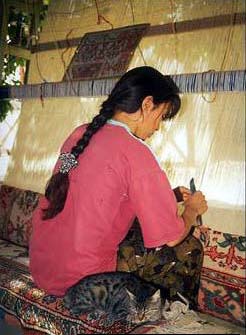|
|
|
PiRLANTA
Carpets,kilims&sumaks
 |
| lopment of Turkish
Rug & Kilim Weaving in Anatolia During
the time time of Selcuk Empire and before they came to Anatolia, Turks
reigned or Iran (Persia) and caucasus for several centuries. The art of
weaving was introduct to Anatoly by the Selcuks toward the end of the
11th. and the begining of 12th. centuries whwn Selcuk sovereignty was at
its strongest. In addition to numerous carpet fragments, many of which are
yet to be documented, there are 18 carpet and fragments which are known to
be of Selcuk Origin. The technical aspects and vast variety of designs
used proves the resourcefullness and the plendor of Selcuk rug weaving.
The oldest surviving Selcuk carpets are dated from the 13th.-14th.
centuries. Eight of these carpets were discovered in the Alaeddin Mosque
in Konya (capital of Anatolian Selcuks) in 1905 by Loytred, a member of
German consulate staff, and were woven at some time between the yaers 1220
and 1250 at the appex of Selcuks reign.
|
 |
 |
 |
 |
| Of these 8 striking rugs, 3 are large complete rugs; 3 are large fragments from small rugs, and 2 are fairly small fragmants originating from large rugs.three more carpet fragments from the Selcuk period were discovered in 1930 in the Esrefoglu Mosque in Beysehir. Today, these rugs are displayed in the Mevlana Museum in Konya and the Kier collection in London. A third group of carpet remmants were recovered in Fostad (old Cairo) in 1935-1936. These 7 rugs from Fostad were identified as having originated in Anatolia in the 14 th. century.the most common design characteristic of the 18 rugs before mentioned are the Kufic border, the eight pointed star, and the hooked (geometric) motif. The Turkish rug, which originated in Central Asia, preserved all of its characteristics until the 14th. century. After the Ottamans gained control over the whole Anatolia, changes began to appearing the composition of the field, in the characteristics of the motifs, and in the sizes of the still traditionally woven Turkish rugs. |